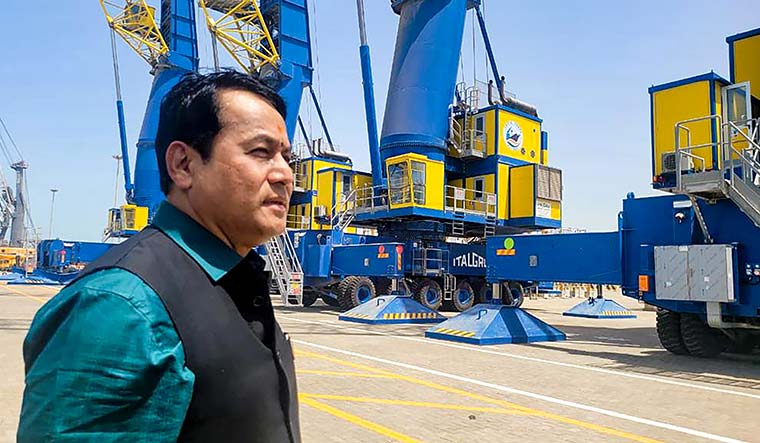Interview/ Sarbananda Sonowal, Union minister of ports, shipping and waterways
Union Minister of Ports, Shipping and Waterways Sarbananda Sonowal said the Chabahar port would serve as a crucial link in the eastern route of the International North-South Transport Corridor, providing faster connectivity between India and Europe. In an exclusive interview with THE WEEK, he also spoke about India’s Sittwe port plan in Myanmar and the significance of the proposed sea route from Vladivostok to eastern India. Edited excerpts:
Q/ It is said that the ongoing wars in Europe and West Asia have further improved the importance of Chabahar.
A/ The Chabahar port’s significance transcends its role as a mere conduit between India and Iran; it serves as a vital trade artery connecting India with Afghanistan and the Central Asian countries. This linkage has unlocked new avenues for trade and fortified supply chain resilience across the region. The establishment of regular ship calls between Chabahar and Indian ports has instilled stability and confidence among traders, offering them visibility and predictability in their supply chain operations. India and Iran have been working on this project since 2003 when prime minister Atal Bihari Vajpayee endorsed this idea. However, it lost steam in between, but under Prime Minister Narendra Modi, it regained its importance. Strategically located, Chabahar offers an alternative transit from the Strait of Hormuz for cargo traffic between Central Asian countries and Afghanistan. This diversification strengthens India’s strategic position in the region.
Q/ You visited Iran twice, most recently on May 13, for the Chabahar deal. How interested is Iran about the project?
A/ India and Iran concluded a historic agreement for the development of the Shahid Beheshti terminal in Chabahar. I had a very fruitful meeting with Mehrdad Bazrpash, the Iranian minister of roads and urban development. Teams from both the countries are working tirelessly to get this deal done as the importance of developing Chabahar as a regional connectivity hub has been agreed at the top level. The development of Chabahar is an India-Iran flagship project. The 10-year lease agreement aims to enhance regional connectivity and facilitate trade, particularly between India, Iran and Afghanistan. It will strengthen India-Iran bilateral ties and will boost the trust of trading communities from the region. India’s sustained engagement in Chabahar under the leadership of Prime Minister Modi highlights the project’s pivotal role in regional trade. The new route, along with other routes that the country is exploring, will help establish India as a major global supply chain partner.
Q/ What is the status of the International North-South Transport Corridor (INSTC)?
A/ Chabahar is envisaged as a crucial link in the eastern route of INSTC, facilitating the movement of goods between India and the Central Asian countries. This collaboration between India and Iran on developing infrastructure and logistics aims to reduce transportation costs and time. Most of the Central Asian countries are keen to explore this route to build and expand trade with the huge South Asian market. It is a far more cost-effective route when compared with the busy Suez route. With the signing of the Chabahar port contract, we are hopeful that our efforts to push for swift operationalisation of the INSTC will be successful.
Q/ What is the potential of the new route from Saint Petersburg to Mumbai via Iran?
A/ India has a longstanding, time-tested and wide-ranging cooperation with Russia. Under the ambit of the Special & Privileged Strategic Partnership, both countries are working towards creating opportunities in all sectors, including trade and commerce. It was agreed in 2014 to enhance bilateral trade between the two countries up to $30 billion, which we have already achieved. In this regard, operationalisation of the ‘green corridor’ (for simplified customs clearance for certain goods) project, implementation of the INSTC and the signing of an FTA between India and the Eurasian Economic Union are important. The INSTC and Chabahar are steps that India has taken to facilitate a smooth, short and swift passage from Saint Petersburg to the Jawaharlal Nehru port in Mumbai. Once operationalised, it will help businesses of Central Asia, East Europe and South Asia to explore an option to bypass the busy Suez canal, saving both time and money.
Q/ Is the civil war in Myanmar the main problem affecting the Sittwe project?
A/ I had the privilege to receive the maiden cargo ship from India last year, marking the beginning of the Sittwe port. This is a very important route for transit of goods to and from northeast India, as it is going to reduce the distance between Mizoram and Kolkata, while reducing the dependence on the Siliguri corridor.
Q/ What are the main benefits that can accrue from the Vladivostok-Chennai trade route?
A/ I represented our country at the Eastern Economic Forum at Vladivostok last year. On the sidelines, we also had a discussion with key stakeholders for the swift operationalisation of the Chennai-Vladivostok route as an alternative trade route. The Eastern Maritime Corridor is aimed at reducing cargo transit times between our nations. It will cover a distance of about 5,600 nautical miles, which is significantly shorter than the current route via the Suez Canal. This corridor holds immense potential to unlock new opportunities for trade and cooperation for both India and Russia. This route is also likely to open up new avenues of trade with Far East markets such as Japan, Korea and China.


